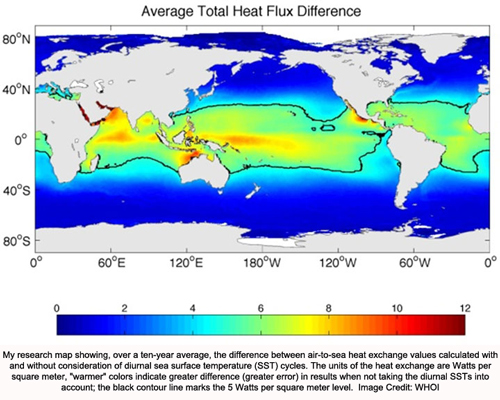Characteristics and Variability of Air-Sea Fluxes
In order to understand how the climate responds to variations in forcing, one necessary component is to understand the full distribution of variability of exchanges of heat and moisture between the atmosphere and ocean. The net flux of heat between the ocean and atmosphere depends on the correlations of the variations of the atmosphere and ocean properties to a greater extent than to their mean values; since the time scales of response are in most cases dissimilar between the ocean and atmosphere the fields are not able to reach an equilibrium balance and thus the fluxes must necessarily be transient. We are using an integrated approach towards determining the interaction of the atmosphere and the ocean through the surface fluxes of heat and moisture on a variety of spatial and temporal scales. In particular, we are seeking to understand the variability and extremes in air-sea fluxes of heat and moisture as a function of their weather state, and how the entire distribution of fluxes varies over time, with location, and with differing climate states.
 A number of satellite-derived products are currently available for addressing these issues, and the increased resolution and quality of many of these products allow for resolution of sub-daily variability. It is thus timely to use these products and comparison model reanalysis data to evaluate more than the means and trends of the heat and moisture fluxes between the ocean and atmosphere. This project uses the full spectrum of variability in these fluxes with associated parameters (such as cloud properties, rainfall, profiles of latent heating, and vertical velocity estimates) to document their distributions with associated weather states, explore the main driving oceanic and atmospheric factors for producing the distributions (and most particularly the extremes), and evaluate to what extent the extremes are affected by larger-scale coupled phenomena such as phases of ENSO and the NAO.
A number of satellite-derived products are currently available for addressing these issues, and the increased resolution and quality of many of these products allow for resolution of sub-daily variability. It is thus timely to use these products and comparison model reanalysis data to evaluate more than the means and trends of the heat and moisture fluxes between the ocean and atmosphere. This project uses the full spectrum of variability in these fluxes with associated parameters (such as cloud properties, rainfall, profiles of latent heating, and vertical velocity estimates) to document their distributions with associated weather states, explore the main driving oceanic and atmospheric factors for producing the distributions (and most particularly the extremes), and evaluate to what extent the extremes are affected by larger-scale coupled phenomena such as phases of ENSO and the NAO.
The key objectives of this study are:
- To provide of the full distribution of the surface heat and moisture fluxes, including variability in means and extremes, throughout the global oceans.
- To determine how local weather states and associated atmospheric components (such as clouds and precipitation) are associated with extremes in the surface fluxes.
- To estimate the importance of the submonthly variability, especially the extremes, affect feedbacks between the ocean and atmosphere.
- To evaluate the influence of large-scale climate variability on distributions of surface flux extremes.
Funding Agencies
The National Aeronautics and Space Administration funded this research.

Partners/Collaborators
This is a joint project with Institution Number One, College Number Two, Organization Number Three, and Corporation Number Four.